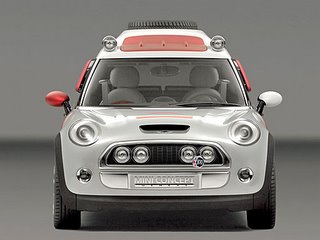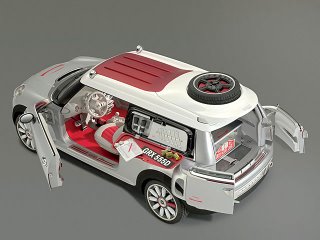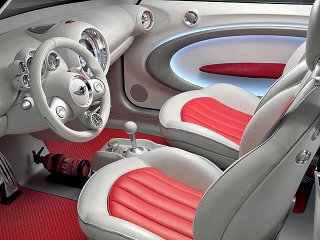2006 Mini Concept Geneva
From 1964 to 1967 Mini dominated the Monte Carlo Rally, setting the foundation for its legendary reputation as a highly agile and nimble sports car.



 Now, commemorating the 100th birthday of Sir Alec Issigonis, the creator of Mini in the year 2006, and as a re¬minder of the outstanding victories scored by the Mini brand some 40 years ago, MINI Concept Geneva offers an up-to-date interpretation of the small British racer in its great days. In particular, this new concept model presents the core idea of the Mini Traveller, Mini Countryman, and Mini Clubman Estate in a highly progressive new model variant.
Now, commemorating the 100th birthday of Sir Alec Issigonis, the creator of Mini in the year 2006, and as a re¬minder of the outstanding victories scored by the Mini brand some 40 years ago, MINI Concept Geneva offers an up-to-date interpretation of the small British racer in its great days. In particular, this new concept model presents the core idea of the Mini Traveller, Mini Countryman, and Mini Clubman Estate in a highly progressive new model variant.
Powerful and elegant looks.
The overall impression conveyed by MINI Concept Geneva is one of strength and muscle, with particular emphasis on individual details such as the car’s wheel arches, its shoulder line and powerdome. MINI Concept Geneva is a clear statement – the car has stance, looks strong and powerful, but is also elegant at the same time.
Cleverness typical of MINI in this special concept.
One of the fundamental ideas in developing MINI Concept Geneva was to make the entire car easy to enter and load. Accordingly, the driver’s/front passenger’s and rear doors all come on special mounts with parallelogram kinematics swivelling in one single movement to the side and to the front and thus offering maximum access to the interior. The rear side sliding windows open electrically.
Cargobox in the luggage compartment.
The luggage compartment of MINI Concept Geneva features a flexible Cargobox with its lid extending out to the rear whenever required to assist the user in loading cargo. The transparent cover on top of the Cargobox also swivels up whenever required, acting as a partition between the passenger compartment and the luggage area.
Sports Utility Box as a multi-purpose storage compartment.
The Sports Utility Box is a multi-functional, additional storage compartment clipped on to the opened rear side window. It features flaps on either side facilitating the process of loading and unloading the Utility Box both from outside and from the passenger compartment, and allowing the driver or passengers to pass through objects transported very practically from one side to the other.
Satellite Silver metallic paintwork and neoprene contours.
MINI Concept Geneva stands out in its beautiful silver paintwork in the light, all points not directly in the beholder’s line of vision being kept in a more discreet grey. Red highlights, in turn, give MINI Concept Geneva a particularly dynamic touch. Soft, resilient neoprene is featured on the black side band so characteristic of the car, extending along the side sills and wheel cutouts.
“Floating Elements” characterising the car’s interior design. Rotating seats for easy access to the rear.
The “Floating Elements” concept offers a supreme impression of generosity and open space right from the start. The seats are suspended in “hovering” arrangement on the centre tunnel, and the free-standing dashboard with its Center Speedo as a swivelling central instrument with both a digital and analogue display further supports and enhances this impression.
Four persons have adequate space in MINI Concept Geneva, with access to the rear facilitated by the front seats swivelling round to the side. After being tilted down, the rear-seat backrests form a flat surface merging directly into the floor of the luggage compartment.
Leather, chrome and aluminium as the principal materials.
Throughout the interior, white leather on various surfaces underlines the impression of modern style and generous space, adding a strong touch of sophisticated class and stylish flair. An aluminium-coated glass-fibre structure, in turn, accentuates the door panels and linings inside the car, while a special carbon-fibre look highlights the foot area in combination with nylon texture carpeting.
Forty-six years of the Mini Traveller.
This special MINI concept made is debut in September 1960 in the guise of the Austin Seven Countryman and Morris Mini Traveller. The term “Traveller” alone made it clear from the start that this par¬ticular Mini was conceived from the beginning for an active target group of connoisseurs and individuals. Total sales between 1960 and 1982 amounted to more than 400,000 units, including the Mini Clubman launched in 1969.
2006: commemorating the 100th birthday of Alec Issigonis, the creator of Mini.
Alexander Arnold Constantine Issigonis was born on 18 November 1906 as the son of a Greek father and a German mother in a region that now belongs to Turkey. After studying engineering in London, he later became one of the most successful automotive engineers and designers in
Great Britain.
Mini and the Monte Carlo Rally.
In winter 1964 a small red David with a white roof proudly showed its tail lights to all the powerful Goliaths, clinching Mini’s first overall win in the Monte Carlo Rally. Virtually overnight the small sub-compact from Britain had become a genuine legend.
© seriouswheels.com
Source: Mini Press Release